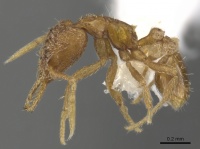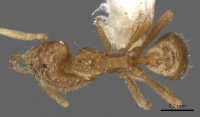Strumigenys nastata
| Strumigenys nastata | |
|---|---|

| |
| Scientific classification | |
| Kingdom: | Animalia |
| Phylum: | Arthropoda |
| Class: | Insecta |
| Order: | Hymenoptera |
| Family: | Formicidae |
| Subfamily: | Myrmicinae |
| Tribe: | Attini |
| Genus: | Strumigenys |
| Species: | S. nastata |
| Binomial name | |
| Strumigenys nastata Bolton, 2000 | |
This species occurs in lowland wet forest, in leaf litter on the forest floor (Longino, Ants of Costa Rica).
Identification
A member of the Strumigenys silvestrii-group.
Bolton (2000) - The four endemic Central American species of the group (Strumigenys calamita, Strumigenys nastata, Strumigenys perdita, Strumigenys timicala) are closely related and share two characters that are not seen elsewhere in the group.
1 The cephalic dorsum has two pairs of short erect simple hairs, one near highest point of vertex, the other near the occipital margin.
2 Spongiform tissue is present on the ventral surface of the petiole.
Of these four species nastata is diagnosed by the presence of a lamella on the leading edge of the scape at the subbasal bend and the relative positions of the preapical mandibular dentition, where the spiniform preapical tooth occurs about midway between the apicodorsal tooth and the proximal denticle. In the other three the scape lacks a lamella and the spiniform preapical tooth is either decidedly closer to the apicodorsal tooth than it is to the proximal denticle, or the proximal denticle is absent. S. calamita and perdita each have the preapical tooth long, spiniform, and widely separated from the apicodorsal tooth of the fork. These preapical teeth are long enough to meet or even overlap when the mandibles are fully closed. In timicala on the other hand the preapical tooth is short and set very close to the apicodorsal tooth; when the mandibles are closed the apices of these teeth remain far apart.
Keys including this Species
Distribution
Latitudinal Distribution Pattern
Latitudinal Range: 8.7° to 8.7°.
| North Temperate |
North Subtropical |
Tropical | South Subtropical |
South Temperate |
- Source: AntMaps
Distribution based on Regional Taxon Lists
Neotropical Region: Costa Rica (type locality).
Distribution based on AntMaps
Distribution based on AntWeb specimens
Check data from AntWeb
Countries Occupied
| Number of countries occupied by this species based on AntWiki Regional Taxon Lists. In general, fewer countries occupied indicates a narrower range, while more countries indicates a more widespread species. |

|
Estimated Abundance
| Relative abundance based on number of AntMaps records per species (this species within the purple bar). Fewer records (to the left) indicates a less abundant/encountered species while more records (to the right) indicates more abundant/encountered species. |

|
Biology
|
Castes
Nomenclature
The following information is derived from Barry Bolton's Online Catalogue of the Ants of the World.
- nastata. Strumigenys nastata Bolton, 2000: 554 (w.) COSTA RICA.
Unless otherwise noted the text for the remainder of this section is reported from the publication that includes the original description.
Description
Worker
Holotype. TL 1.7, HL 0.42, HW 0.32, CI 76, ML 0.25, MI 60, SL 0.26, SI 81, PW 0.22, AL 0.42. Preapical tooth of mandible separated from apicodorsal by a distance about equal to its length; a small preapical denticle also present, just proximal of mandibular midlength. The distance separating the preapical and apicodorsal teeth is about the same as that separating the preapical tooth from the denticle. Scape with a pronounced subbasal bend; leading edge of scape with a projecting narrow cuticular lamella that arises proximal of the subbasal bend, follows its curvature, and peters out along the margin distal of the subbasal bend. Curved hairs on leading edge of scape narrowly spatulate, slightly shorter than maximum scape width. With head in full-face view the curved hairs that fringe the upper scrobe margins, and the cephalic ground-pilosity, narrowly spatulate. Apicoscrobal hair long, fine and flagellate. Cephalic dorsum with two pairs of fine short erect hairs; one pair close to highest point of vertex, the other near the occipital margin. Pronotal humeral hair flagellate; an erect pair of flagellate hairs on mesonotum. First gastral tergite with scattered erect hairs, a few of which are weakly flagellate; others are narrowly looped apically and in profile appear truncated (may be damaged). Posteriorly on the tergite there are also some fine soft hairs that are more reclinate and curved posteromedially. Propodeum with a tooth, subtended by a lamella that is not dentiform or angulate basally. In profile petiole with a ventral curtain of spongiform tissue and the lateral lobe of the node large and spongiform; height of anterior face of node about equal to, or slightly less than, length of dorsum (excluding posterior collar). In dorsal view petiole node broader than long; disc of postpetiole smooth, with 1-2 weak rugulae toward the dorsolateral margins. Basigastral costulae strong, longer than disc of postpetiole.
Type Material
Holotype worker, Costa Rica: Provo Puntarenas, Osa, Rancho Quemado, 8°42'N, 83°33'W, 2-300 m., 15.xii.1990, wet forest, ex sifted leaf litter, #2760-S (J. Longino) (The Natural History Museum).
References
- Bolton, B. 2000. The ant tribe Dacetini. Memoirs of the American Entomological Institute. 65:1-1028. (page 554, worker described)

